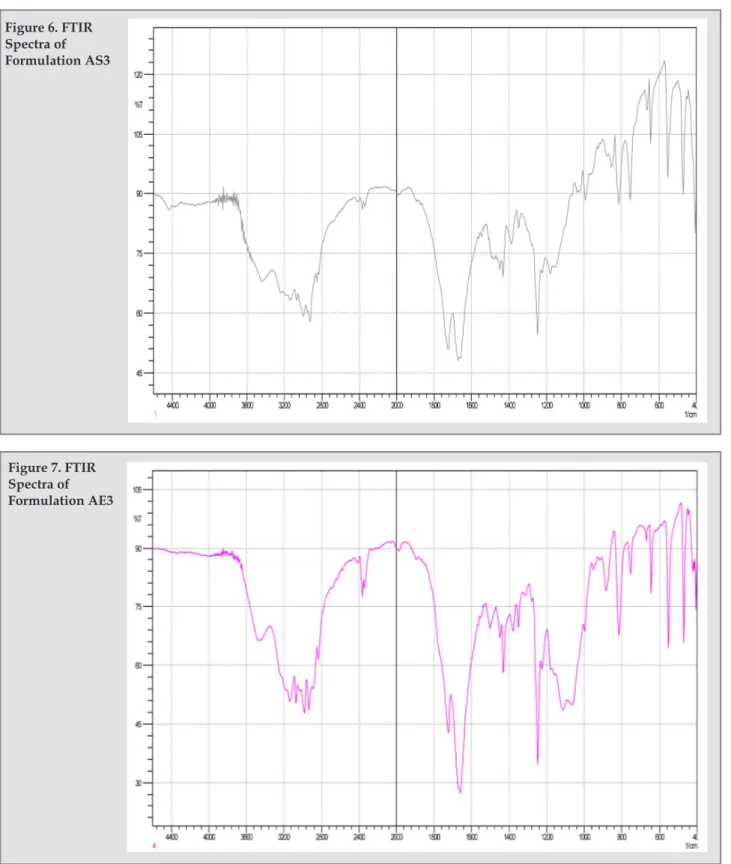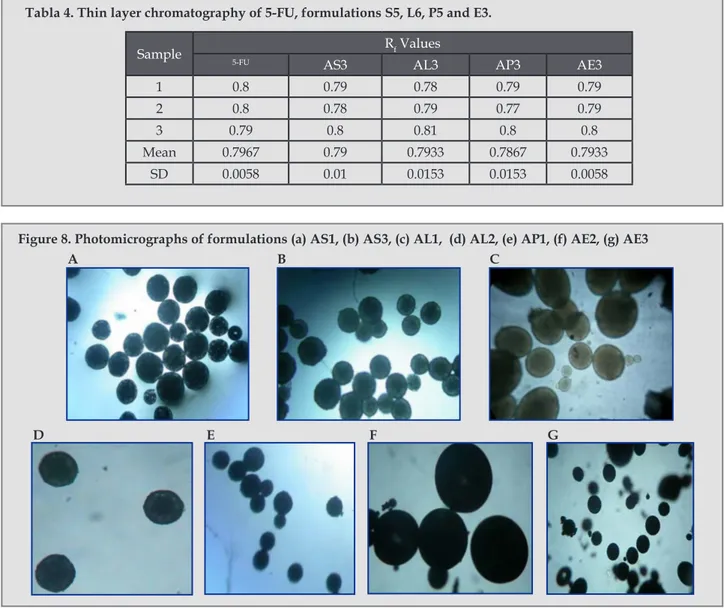Preparation and characterization of 5 fu loaded microspheres of eudragit and ethylcellulose
Texto completo
(2) Ars Pharmaceutica Preparation and characterization of 5-fu microspheres of eudragit and ethylcellulose. loaded. Vaghani SS,1 Jivani NP,1 Serasia TH,1 Vasanti S,2 Satish CS,2 Patel MM.3 1. Smt. R. B. Patel Mahila Pharmacy College. Atkot. Gujarat. India. 2 Dept. of Pharmaceutics, PES College of Pharmacy, Hanumanthnagar, Bangalore. India. 3. Kalol Institute of Pharmacy, Kalol. Gujarat. India.. Original Article Artículo Original Corrospondance: Vaghani SS Smt. R. B. Patel Mahila Pharmacy College. Atkot. Gujarat. India e-mail:subhashvaghani@gmail.com. Received: 08/06/2010 Accepted: 28/03/2011. ABSTRACT. In the present investigation, 5-fluorouracil loaded microspheres of Eudragit (RS 100, RL 100 and RSPO) and ethylcellulose were prepared. “O/O solvent evaporation” technique was used for preparation of microspheres using (methanol + acetone)/liquid paraffin system. Magnesium stearate was used as the droplet stabilizer and n-hexane was added to harden the microspheres. The prepared microspheres were characterized for their micromeretic properties and entrapment efficiency; as well by Fourier transform infrared spectroscopy (FTIR) and thin layer chromatography (TLC). Photomicrographs were taken to study the shape of microspheres. The best fit release kinetics was achieved with Higuchi plot. Mean particle size, entrapment efficiency and production yields were highly influenced by the type of polymer and polymer concentration. It is concluded from the present investigation that various Eudragit and Ethylcellulose are promising controlled release carriers for 5-FU. KEY WORDS: 5-fluorouracil, Eudragit RS 100, Eudragit RL 100, Eudragit RSPO,. Ethylcellulose, microspheres, solvent evaporation.. RESUMEN. En la presente investigación, se han preparado microesferas de Eudragit (RS 100, RL 100 y RSPO) y etilcelulosa cargadas con 5-fluorouracilo. Se ha utilizado la técnica de “evaporación del disolvente o/o” para preparar las microesferas utilizando el sistema de (metanol + acetona)/ parafina líquida. Se ha utilizado estearato de magnesio como estabilizador de gotículas y se ha añadido n-hexano para endurecer las microesferas. Las microesferas preparadas se caracterizan por sus propiedades micromeríticas y su eficaz compresión, así como a través de la espectroscopia infrarroja transformada de Fourier (FTIR, por sus siglas en inglés) y la cromatografía en capa fina. Se han tomado microfotografías para estudiar la forma de las microesferas. La mejor cinética de liberación se ha alcanzado con el modelo de Higuchi. El tamaño de la partícula principal, la eficacia de compresión y los rendimientos de producción han sido fuertemente influenciados por el tipo de polímero y su concentración. Tras la presente investigación, se ha determinado que el Eudragit y la Etilcelulosa tienen carreras muy prometedoras en la liberación controlada para el 5-FU PALABRAS CLAVE: 5-fluorouracilo, Eudragit RS 100, Eudragit RL 100, Eudragit. RSPO, Etilcelulosa, microesferas, evaporación del disolvente.. Ars Pharm. 2011; 52(1): 23-30.. 23.
(3) Vaghani SS, Jivani NP, Serasia TH, Vasanti S, Satish C S,2 Patel MM.. INTRODUCCIÓN 5-Fluorouracil (5-FU) is an antimetabolite of the pyrimidine analog class which is widely used alone or in combination chemotherapy regimens. It interferes with nucleic acid synthesis, inhibits DNA synthesis, and eventually inhibits cell growth1. It has been the only agent with clinical activity against colorectal cancer. It is also used for malignancies, such as those of the breast, head and neck1. 5-FU is poorly absorbed after oral administration with extremely variable bioavailability2. These disadvantages make it an appropriate candidate for microencapsulation. Microspheres are one of the multiparticulate delivery system and are prepared to obtain prolonged or controlled drug delivery to improve bioavailability or stability and to target drug to specific sites. Microspheres can also offer advantages like limiting fluctuation within therapeutic range, reducing side effects, decreasing dosing frequency and improving patient compliance3. Eudragit polymers are series of acrylate and methacrylate polymers available in different ionic forms. Eudragit RL 100, Eudragit RS 100 and Eudragit RSPO are insoluble in aqueous media but they are permeable and have pH-independent release profiles. The permeability of all the three polymers in aqueous media is due to the presence of quarternary ammonium groups in their structure; Eudragit RL 100 has a greater proportion of these groups and as such is more permeable than Eudragit RS 100 and Eudragit RSPO, while Eudragit RS 100 and Eudragit RSPO have same permeability due to their structural similarity. They differ in the physical forms where the previous has granular form and later has powder form. Ethylcellulose is an ethyl ether of cellulose, a long chain polymer consisting of anhydroglucose units joined together by acetal linkages. It is not metabolized following oral consumption and is therefore a noncaloric substance. It is generally regarded as a nontoxic, nonallergenic and nonirritant material. The main use of it in oral formulations is as a hydrophobic coating agent for tablets and granules. Release of a drug from its microcapsule is a function of capsule wall thickness. The aim of this study was to prepare Eudragit and ethylcellulose microspheres containing 5-FU to achieve a controlled drug release profile suitable for peroral administration. The microspheres were prepared by solvent evaporation technique using Eudragit and Ethylcellulose as a matrix polymer. (Methanol + acetone)/ Liquid paraffin system was used for the preparation of microspheres. Magnesium stearate was used as a droplet stabilizer to prevent droplet coalescence in the oil medium and n-hexane was added as a non-solvent to the processing medium to solidify the microspheres4. Firstly, we investigated formulation variables (polymer type and drug:polymer ratio) to obtain spherical particles. The effects of various Eudragit and Ethylcellulose on the yield 24. of production, particle size distribution, encapsulation efficiency and 5-FU release rate from microspheres were investigated. The influences of formulation variables on the microsphere properties were examined. The prepared spherical microspheres were evaluated for micromeritic properties and drug content, and also by FTIR, TLC as well as for in vitro drug release studies4. MATERIALS AND METHODS Materials Eudragit RS 100, Eudragit RL 100 and Eudragit RSPO, Rohm Pharma; Ethylcellulose, S. D. Fine chem. Ltd; 5-FU, Biochem; Magnesium sterate, Ottokemi; n-hexane, Spectrochem; Liquid paraffin Light, Central Drug House; Methanol, Central Drug House; Acetone, Central Drug House; Petroleum ether, Labort; Toluene, Merck; Other substances used were all of pharmaceutical grade. Methods Preparation of microspheres The technique used in preparation of microspheres was “O/O emulsion” solvent evaporation. As shown in table 1, three different formulations of each polymer (Eudragit RS 100, Eudragit RL 100, Eudragit RSPO and Ethylcellulose) with drug (5-FU) in different drug:polymer ratios 1:1, 1:2, and 1:3 were prepared. The polymers were dissolved in 10 ml of acetone separately. Pure 5-FU was dissolved in 13 ml of methanol. Both the solutions were mixed and 10 mg of Mg-stearate was dispersed in solution containing polymer and 5-FU. The dispersion was then stirred for 15 min. using magnetic stirrer. The resultant dispersion was then poured into 500 ml beaker containing the external phase (135 ml liquid paraffin light + 15 ml n-hexane) with stirring. Threeblade mechanical stirrer was used. Stirring (at 750 rpm) was continued for 4 hrs until acetone and methanol had evaporated completely. After evaporation of solvents, the microspheres formed were filtered using Whatman no. 41 filter paper. The residue was washed 4-5 times in 25 ml n-hexane followed by 4-5 times in 50 ml petroleum ether (40˚C – 60˚C). Thereafter, the microspheres were dried in a desiccator for 24 h at room temperature. The microspheres were then stored in the desiccator4. Production yield The yield was calculated by dividing the weight of the collected microspheres by the weight of all the non-volatile components used for the preparation of microspheres and expressed in the terms of percentage5. Percent Yield = (the amount of microspheres obtained/ the theoretical amount) x 100 Ars Pharm. 2011; 52(1): 23-30..
(4) Preparation and characterization of 5-fu loaded microspheres of eudragit and ethylcellulose. Tabla 1. Formulae for 5-FU loaded microspheres. Formulation. Drug (mg). AS1. Significación clínica. Mg-stearate (mg). Curing time (h). -. 10. 4. -. -. 10. 4. RS100. RL100. RSPO. EC. 100. 100. -. -. AS2. 100. 200. -. AS3. 100. 300. -. -. -. 10. 4. AL1. 100. -. 100. -. -. 10. 4. AL2. 100. -. 200. -. -. 10. 4. AL3. 100. -. 300. -. -. 10. 4. AP1. 100. -. -. 100. -. 10. 4. AP2. 100. -. -. 200. -. 10. 4. AP3. 100. -. -. 300. -. 10. 4. AE1. 100. -. -. -. 100. 10. 4. AE2. 100. -. -. -. 200. 10. 4. AE3. 100. -. -. -. 300. 10. 4. Particle size distribution analysis Formulations of the microspheres were analyzed for particle size by optical microscope. The instrument was calibrated and found that 1unit of eyepiece micrometer was equal to 7.5 µm. 300 microspheres’ sizes were calculated under 10 X magnification6. Drug Entrapment efficiency (DEE) Ten mg 5-FU loaded microparticles were dissolved in 100 ml of PBS (pH 7.4) by shaking with magnetic stirrer for 24 h. The solution was filtered through Whatman no. 41 filter paper. An aliquot was assayed spectrophotometrically (UV-1601 Schimadzu Corporation, Japan) for 5-FU at 266 nm. Drug entrapment efficiency was determined by using the following relationship. % Entrapment = (Actual content/ Theoretical content) x 100 In vitro drug release study The dissolution rate of 5-FU from the microspheres were studied using phosphate buffer solution (PBS) pH 7.4 by paddle method (USP XXIII). Accurately weighed microspheres (equivalent to 10 mg of 5-FU) were taken for dissolution studies. The dissolution medium was kept at 37 ± 0.5˚C. Aliquots of sample were withdrawn at predetermined intervals of time and analyzed for drug release by measuring the absorbance at 266 nm. The volume withdrawn at each time intervals replaced with the same amount of fresh dissolution medium. Release Kinetics Data obtained from in vitro release studies were fitted to Ars Pharm. 2011; 52(1): 23-30.. various kinetics equations to find out the mechanism of drug release from microsphers. The kinetic models used were Zero order, First order, Higuchi and KorsemeyerPeppas models. The rate constants were also calculated for the respective models4. FTIR Study Drug-polymer interactions were studied by FTIR spectroscopy. IR spectra for drug and drug loaded microspheres were recorded in a Fourier transform infrared (FTIR) spectrophotometer (FTIR-8400 S, Shimadzu, Japan) with KBr pellets. The scanning range was 400-4000 cm-1. Thin Layer Chromatography (TLC) Pure 5-FU and drug loaded microspheres were dissolved in methanol separately and about 10 µg samples were spotted on precoated silica gel G plate. The solvent used was methanol. The plates were developed for at least 10 cm and then air dried. The Rf values were calculated and compared with the monographs7. Photomicrographs of microspheres To study the shape of microspheres, photograph were taken using trinocular microscope (labomed, Olympus, CXRii) attached with camera. RESULTS AND DISCUSSION Mean particle size The effects of parameters like the type of polymer and polymer concentration on the production yield, entrapment efficiency, particle size distribution, in vitro drug release and drug polymer interaction were studied. 25.
(5) Vaghani SS, Jivani NP, Serasia TH, Vasanti S, Satish C S,2 Patel MM.. In the preparation methanol was used to dissolve the drug. As shown in table 2, the mean particle size for the formulations of Eudragit RS 100 was obtained in the range of 42.5 ± 3.387 µm to 44.3 ± 4.405 µm, for Eudragit RL 100 it was 58.1 ± 1.345 µm to 80.1 ± 3.345 µm, for Eudragit RSPO, it was 99.5 ± 3.245 µm to 123.0 ± 8.479 µm and for Ethylcellulose it showed the range between 226.9 ± 5.214 µm to 267.1 ± 3.857 µm. Production Yield Production yields of the preparation for all the polymers and polymer concentrations were found to be very less. As shown in table 2, for Eudragit RS 100 the % yield was obtained in the range of 8.38 ± 0.652 to 21.45 ± 0.661, for Eudragit RL 100 it was 13.78 ± 0.833 % to 29.48 ± 0.883 %, for Eudragit RSPO it was 12.50 ± 1.176 % to 22.85 ± 2.553 % and for Ethylcellulose it showed the range 12.78 ± 0.937 % to 17.42 ± 1.889 %. Entrapment efficiency As shown in table 2, the entrapment efficiency was less for all formulations. As shown in table 2, for Eudragit RS 100 the entrapment efficiency was obtained in the range of 28.80 ± 2.405 % to 39.18 ± 2.660 %, for Eudragit RL 100 it was 22.36 ± 3.887 % to 35.63 ± 2.792 %, for Eudragit RSPO it was 28.45 ± 1.463 % to 40.63 ± 1.802 % and for Ethylcellulose and it showed in the range of 25.71 ± 2.785 % to 44.53 ± 3.181 %. The data revealed that particle size, entrapment efficiency, was highly influenced by type of polymer, polymer concentration and solvent used to dissolve the drug and polymer3,8-11. Methanol was used to dissolve the drug for all the formulations and it was found to be important factor. to affect the production yield. The polymers were sticking to the vessel and the stirrer while evaporation of methanol, resulted in less production yield. In Vitro Release Study In vitro release studies of the formulations were carried out in the PBS (pH 7.4) at 37 ± 0.5 ˚C. As shown in fig 1, 2, 3 and 4 the initial higher release of 5-FU from all the formulations was might have resulted from the dissolution of the drug crystals presented on the surface of the microspheres11. The formulations of Eudragit RS, AS1, AS2 and AS3 showed the complete drug release after 8, 9 and 11 h respectively as shown in figure 1. The formulations of Eudragit RL, AL1, AL2 and AL3 as shown in figure 2 were not able to sustain the drug release for 12 h and completely released after 5, 5, 8 h respectively. Release rates of 5-FU from Eudragit RL were faster than from Eudragit RS due to the fact, that the amount of quarternary ammonium groups of Eudragit RS is lower than that of Eudragit RL, therefore, Eudragit RL is more permeable to water, so that release was less retarded3. The formulations of Eudragit RSPO, AP1, AP2 and AP3 were also not able to sustain the drug release for 12 h and completely released after 9, 9 and 10 h respectively as shown in figure 3. The release of Eudragit RSPO microspheres was nearly same as that of Eudragit RS due to the same characteristics of both the polymers. As shown figure 4, formulations E1 and E2 were failed to sustain the drug release up to 12 h and showed complete release after 9 h and 10 h respectively. Formulation E3 was the only formulation showing about 97 % release after 12 h, hence it was chosen as the optimized formulation. The dissolution data revealed that for all the formulations as. Tabla 2. Percentage production yield, mean particle size and percentage entrapment efficiency of Formulations AS1-AE3 Formulations. % yield *. Mean Particle Size* (µm). % Entrapment Efficiency*. AS1. 8.38 ± 0.652. 42.5 ± 3.387. 28.80 ± 2.405. AS2. 14.47 ± 1.063. 43.5 ± 1.100. 33.09 ± 3.779. AS3. 21.45 ± 0.661. 44.3 ± 4.045. 39.18 ± 2.660. AL1. 13.78 ± 0.833. 58.1 ± 1.345. 22.36 ± 3.887. AL2. 19.37 ± 0.682. 72.6 ± 4.943. 29.49 ± 2.842. AL3. 29.48 ± 0.883. 80.1 ± 3.345. 35.63 ± 2.792. AP1. 12.50 ± 1.176. 99.5 ± 3.245. 28.45 ± 1.463. AP2. 17.15 ± 2.038. 118.8 ± 2.179. 34.98 ± 1.637. AP3. 22.85 ± 2.553. 123.0 ± 8.479. 40.63 ± 1.802. AE1. 12.78 ± 0.937. 226.9 ± 5.214. 25.71 ± 2.785. AE2. 16.64 ± 1.678. 247.7 ± 6.736. 34.71 ± 2.979. AE3. 17.42 ± 1.889. 267.1 ± 3.857. 44.53 ± 3.181. * indicates average of three readings ± SD. 26. Ars Pharm. 2011; 52(1): 23-30..
(6) Preparation and characterization of 5-fu loaded microspheres of eudragit and ethylcellulose. Figure 1. In vitro release profile of 5-FU (n=3) from AS1, AS2 and AS3 formulations.. Figure 2. In vitro release profile of 5-FU (n=3) from AL1, AL2 and AL3 formulations.. Figure 3. In vitro release profile of 5-FU (n=3) from AP1, AP2 and AP3 formulations.. Figure 3. In vitro release profile of 5-FU (n=3) from AP1, AP2 and AP3 formulations.. the polymer concentration was increased, the drug release rate decreased, depending on the drug-polymer ratio9.. cm-1 and 1657 cm-1 for C=O stretching, 1245 cm-1 for CH in plane deformation and 813 cm-1 for CH out of plane deformation7. They were checked in the IR spectrum of optimized formulations. As shown in the Figure 5, Figure 6 and Figure 7, there were no significant difference in the IR spectra of pure 5-FU and drug loaded formulations AS3 and AE3.. Release Kinetics The release kinetics of all the formulation was checked by fitting the release data to various kinetic models, and the release was best fitted to the Higuchi model. It was further confirmed by fitting the data to Korsmeyer-Peppas equation and the n value for all the formulations obtained between 0.2769 and 0.4399 revealed that the release was followed square root of time mechanism1. The R2 values for all the models are shown in table 3. FTIR spectroscopy Drug polymer interaction was checked by the IR spectrum of the optimized formulations with the IR spectrum of pure drug. The IR spectrum of pure drug shows the characteristic peaks at 3124 cm-1 for NH stretching, 1716. Ars Pharm. 2011; 52(1): 23-30.. TLC study TLC of pure drug and that of formulations were carried out using methanol as solvent system on precoated silica gel plate. Iodine vapor was used for detection of spots. The Rf values for pure drug and the formulations are reported in table 4. FTIR and TLC study suggested drug stability and no drugpolymer interaction was occurred during the encapsulation process. Photomocrograph study revealed the sphere shape of microspheres. 27.
(7) Vaghani SS, Jivani NP, Serasia TH, Vasanti S, Satish C S,2 Patel MM.. Tabla 3. Correlation coefficients of different mathematical models for 5-FU microspheres. Zero order. First order. Higuchi. R. R. R. n. R2. AS1. 0.8471. 0.9342. 0.9913. 0.3634. 0.9961. AS2. 0.8755. 0.9124. 0.9941. 0.3813. 0.9968. 3. AS3. 0.8147. 0.8867. 0.9937. 0.3642. 0.9976. 4. AL1. 0.9823. 0.9564. 0.9931. 0.2769. 0.9886. 5. AL2. 0.9692. 0.8714. 0.9901. 0.3893. 0.9817. 6. AL3. 0.9472. 0.9486. 0.9910. 0.3267. 0.9912. 7. AP1. 0.8728. 0.9291. 0.9904. 0.4399. 0.9962. 8. AP2. 0.8364. 0.8341. 0.9868. 0.3540. 0.9951. 9. AP3. 0.8354. 0.8352. 0.9912. 0.3826. 0.9905. 10. AE1. 0.7620. 0.9611. 0.9882. 0.3048. 0.9943. 11. AE2. 0.7967. 0.9768. 0.9876. 0.3161. 0.9973. 12. AE3. 0.8186. 0.9789. 0.9933. 0.3400. 0.9971. Sl.. Formulations. 1 2. 2. 2. 2. Korsemeyer Peppas. Figure 5. FTIR Spectra of pure 5-FU.. Photomicrographs of microspheres To study the shape of microspheres photograph were taken using trinocular microscope (labomed, Olympus, CXRii) attached with camera. Study revealed the spherical shape of the microspheres as shown in figure 8. CONCLUSION 5-FU microspheres were prepared easily and successfully using the solvent evaporation technique. The yield and 28. entrapment efficiency were found to be very less for all the formulations prepared. Particle size obtained for the microspheres was less for all the formulations. Particle size, entrapment efficiency and production yield were found to be highly influenced by the type of polymer and polymer concentration. It was found that the release of drug from the formulations followed diffusion mechanism. The release kinetics of all the formulations was best fitted to the Higuchi model which revealed that the release followed Ars Pharm. 2011; 52(1): 23-30..
(8) Preparation and characterization of 5-fu loaded microspheres of eudragit and ethylcellulose. Figure 6. FTIR Spectra of Formulation AS3. Figure 7. FTIR Spectra of Formulation AE3. square root of time mechanism. According to the results of FTIR and TLC no drug interaction was occurred with polymer and 5-FU was found to be in crystal form in the prepared microspheres. REFERENCE 1.Rahman Z, Kohli K, Khar RK, Ali M, Charoo MA, Shamsher AAA. Characterization of 5-fluorouracil microspheres for colonic drug. AAPS Pharma Sci Tech. 2006; 7(2):E1-E9. Ars Pharm. 2011; 52(1): 23-30.. 2. Zinnuti C, Barberi-Heyob M, Hoffman M, Maincent P. In-vivo evaluation of sustained release microspheres of 5-FU in rabbits. Int J Pharm. 1998; 166(2):231-234. 3. Haznedar S, Dortunc B. Preparation and in vitro evaluation of eudragit microspheres containing acetazolamide. Int J Pharm. 2004; 269(1):131-140. 4. Sahoo SK, Mallick AA, Barik BB, Senapati PC. Formulation and in vitro evaluation of eudragit microspheres of stavudine. Trop J Pharm Res. 2005; 4(1):369-375.. 29.
(9) Vaghani SS, Jivani NP, Serasia TH, Vasanti S, Satish C S,2 Patel MM.. Tabla 4. Thin layer chromatography of 5-FU, formulations S5, L6, P5 and E3. Rf Values. Sample. 5-FU. AS3. AL3. AP3. AE3. 1. 0.8. 0.79. 0.78. 0.79. 0.79. 2. 0.8. 0.78. 0.79. 0.77. 0.79. 3. 0.79. 0.8. 0.81. 0.8. 0.8. Mean. 0.7967. 0.79. 0.7933. 0.7867. 0.7933. SD. 0.0058. 0.01. 0.0153. 0.0153. 0.0058. Figure 8. Photomicrographs of formulations (a) AS1, (b) AS3, (c) AL1, (d) AL2, (e) AP1, (f) AE2, (g) AE3 A B C. D. E. 5. Chun MK, Sah H, Choi HK. Preparation of mucoadhesive microspheres containing antimicrobial agents for eradication of H. Pyroli. Int J Pharm. 297(1-2):172-179. 6. Polk A, Amsden K, Yao D, Peng T, Goosen MF. Controlled release of albumin from chitosan-alginate microcapsules. J Pharm Sci. 1994; 83(2):178-185. 7. Baomi SM, Al-badar AA. Fluorouracil. In: Florey K. Analytical profile of drug substances. Vol. 18, Elsevier Publication. New Delhi, 2005. p. 599-632. 8. Bhalerao SS, Lalla JK, Ranem MS. Study of processing parameters influencing the properties of diltiazem hydrochloride microspheres. J microencapsul. 2001; 18(3):299-307.. 30. F. G. 9. Sengel CT, Hascicek C, Gonul N. Development and in vitro evaluation of modified release tablets including ethylcellulose microspheres loaded with diltiazem hydrochloride. J microencapsul. 2006; 23(2):135-52. 10. Lamprecht A, Yamamoto H, Takeuchi H, Kawashima Y. Design of pH-sensitive microspheres for the colonic delivery of the immunosuppressive drug tacrolimus. Eur J Pharm Biopharm. 2004; 58(1):37-43. 11. Paharia A, Yadav AK, Rai G, Jain SK, Pancholi SS, Agrawal GP. Eudragit-coated pectin microspheres of 5-Florouracil for colon targeting. AAPS Pharm Sci Tech. 2007; 8(1):E1-E7. Ars Pharm. 2011; 52(1): 23-30..
(10)
Figure
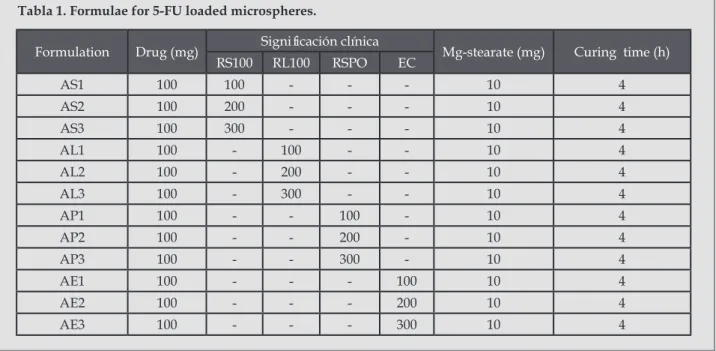
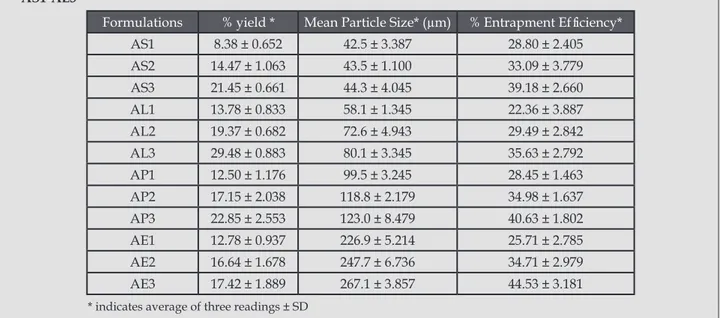
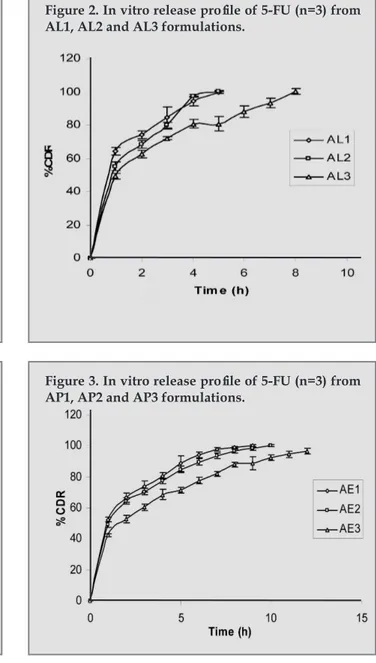
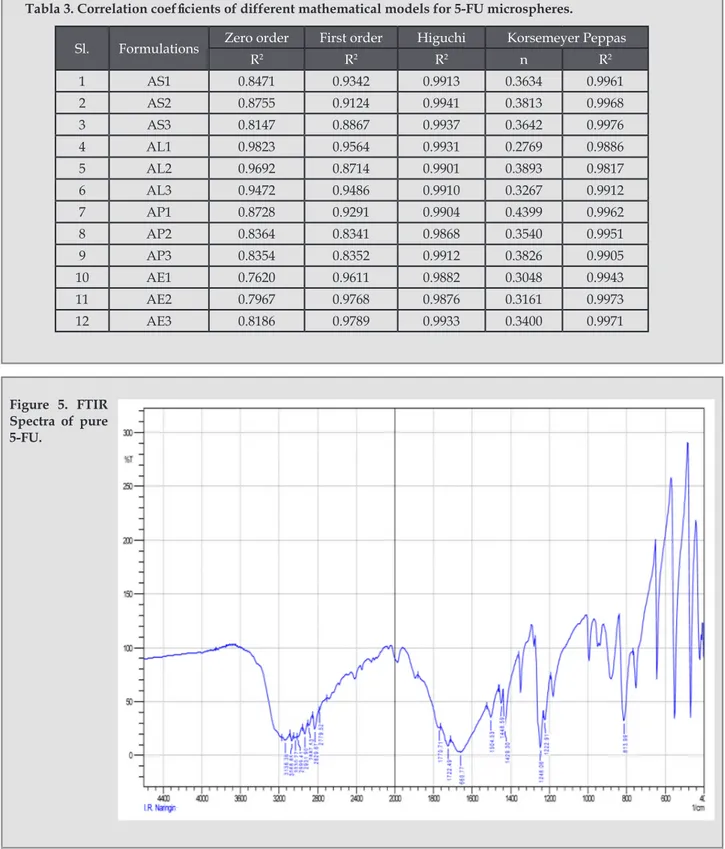
Documento similar
In this respect, a comparison with The Shadow of the Glen is very useful, since the text finished by Synge in 1904 can be considered a complex development of the opposition
Safety and performance of the drug-eluting absorbable metal scaffold (DREAMS) in patients with de-novo coronary lesions: 12 month results of the prospective, multicentre,
Since such powers frequently exist outside the institutional framework, and/or exercise their influence through channels exempt (or simply out of reach) from any political
Of special concern for this work are outbreaks formed by the benthic dinoflagellate Ostreopsis (Schmidt), including several species producers of palytoxin (PLTX)-like compounds,
In the previous sections we have shown how astronomical alignments and solar hierophanies – with a common interest in the solstices − were substantiated in the
While Russian nostalgia for the late-socialism of the Brezhnev era began only after the clear-cut rupture of 1991, nostalgia for the 1970s seems to have emerged in Algeria
If the concept of the first digital divide was particularly linked to access to Internet, and the second digital divide to the operational capacity of the ICT‟s, the
1. S., III, 52, 1-3: Examinadas estas cosas por nosotros, sería apropiado a los lugares antes citados tratar lo contado en la historia sobre las Amazonas que había antiguamente
